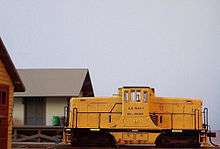Kader
Kader Industrial Company Limited was founded in Hong Kong in 1948 by Ting Hsiung Chao. It was listed on the Hong Kong Stock Exchange in 1985 and presently trades under the name of "Kader Holdings Company Limited".
The company today is one of the world's largest manufacturers of toy and hobby railways, and also has wider manufacturing interests as well as substantial investments in property. The vision of Mr. Ting Hsiung Chao is shared by the Ting family, which continues to lead the Kader Group.
Kader's initial focus product was to manufacture plastic flashlights, which at the time were a novelty.
Present day
Today the companies main facilities are located in Dongguan, PRC. Manufacturing operations are divided into two categories, ODM manufacturing (the contract manufacturing of goods for the brand/design owner); and manufacturing of precision model railroads designed and marketed by Kader group companies. ODM customers have included toys for Disney, Hasbro and Mattel; and electrical goods housings for National Panasonic.
Model Railways

In light of falling profits, financial difficulties, and its inability to compete with Kader, its customer 'Bachmann Bros.', in 1984 Kader acquired Bachmann. It changed the name to Bachmann Industries and used the brand to draw in North American customers.
As well as introducing its own brands to North America, Kader under the Bachmann brand built itself up as the largest volume seller of model railways by purchasing other failing companies, using the Bachmann name to front a series of purchases in the rest of the world to combat the then poor perceptions of Hong Kong-based production quality. In 1989 a European division was set up initially reusing the moulds previously used for the Palitoy 'Mainline' UK model railway products to create the Bachmann Branchline models. 1992 it bought Liliput of Austria and in 2000 it bought Graham Farish. In 2007 it acquired the assets of Williams models and launched "Williams by Bachmann".
Kader's business model for each take over, from its original purchase of Bachmann to the present day, is to buy a perceived quality brand in the target market or country. The company then closes local in-country production facilities, and then improves quality by re-engineering the models in Hong Kong, and reduces cost by producing the models in mainland China.
Presently Bachmann offers trains in H0 scale, N scale, On30, and G scale around the world, in addition to buildings and accessories:
- North America - Bachmann Industries, Williams by Bachmann
- United Kingdom - Bachmann Branchline offer 00 gauge models, while Graham Farish produce British scale (1:148) N gauge models under the Graham Farish name
- Europe - Liliput and Palitoy
- China - from 2000, Bachmann also started producing Chinese outline models under the Bachmann China name, opening the world's first Bachmann speciality retail shop in Shanghai in 2005
In November 2008, Kader also took over Sanda Kan, its nearest competitor for precision model railway items in the Hong-Kong based ODM contract manufacturing business.[1][2] Sanda Kan's biggest client had been Bachmann's dominant rival in the UK market Hornby Railways, which had concentrated production there since 1997-2001.[3] The company also manufactured for Lionel, Atlas, Life-Like, Brawa, Märklin, and of the order of 50 other model train companies.[4][5] However it had been experiencing severe production and debt problems after a takeover by J.P. Morgan private equity. The merger was hailed by one producer as "a marriage made in heaven",[4] although it is not yet clear what long-term effects the concentration of the ownership of production will have. Kader announced that Sanda Kan would continue as a distinct entity, and that Sanda Kan's original owner W.S. Ting had agreed to come back to lead the company. Hornby's managing director pronounced the acquisition "a welcome outcome [that] removes the uncertainty over the future of Sanda Kan".[6] Most Hornby production has so far remained with Sanda Kan, although the company has also been talking with three alternative suppliers.[7][8]
Disaster in Kader's Thailand factory
On May 10, 1993, there was a major fire at the Kader Toy Factory, a joint venture, almost 80% owned by Kader,[9] in Thailand. 188 people were killed, and over 500 were seriously injured. Most of the victims were young female workers from rural families. More people were killed in this industrial accident than in the Triangle Shirtwaist Factory fire; making it one of the worst industrial disaster in history.[10] Despite being the worse industrial disaster in history,[11] it received little corporate-owned-media attention outside Thailand. Possibly due to it being a child labor camp[12] or possibly due Kader's connections to major corporates such Disney, Hasbro and Mattel (see paragraph above).
References
- ↑ Sanda Kan purchased by Kader Holdings, Bachmann Press Release, 20 November 2008.
- ↑ Kader Holdings Company Limited, Announcement: Very Substantial Acquisition and Resumption of Trading, 17 November 2008
- ↑ One The Right Track, China-Britain Business Council, 2005 Archived December 6, 2008, at the Wayback Machine.
- 1 2 Lewis Polk, of Aristocraft Trains: Re: Kader buys Sanda Kan, 14 November 2008
- ↑ Gareth Bayer, Do you know what is made where?, 24 September 2008
- ↑ Frank Martin, Announcement - Sanda Kan, Hornby plc Investor News, 19 November 2008
- ↑ Ian King, Problem with supplier sends Hornby off the rails, The Times, 6 June 2009
- ↑ Phakamisa Ndzamela, Hornby sees 2010 revenue up 10-11 pct, Reuters, 5 June 2009
- ↑
- ↑ Thai toy factory fire: 10 years after the world's worst industrial inferno
- ↑ Thai toy factory fire: 10 years after the world's worst industrial inferno
- ↑ Thai toy factory fire: 10 years after the world's worst industrial inferno
External links
https://commons.wikimedia.org/wiki/File:Kader2.jpg https://commons.wikimedia.org/wiki/File:Kader1.jpg